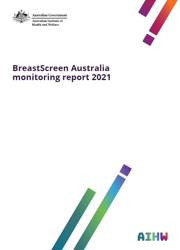Summary
BreastScreen Australia is the national breast cancer screening program. It aims to reduce illness and death from breast cancer through an organised approach to the early detection of breast cancer, using screening mammography to detect unsuspected breast cancer in women. Early detection provides an opportunity for early treatment, which can reduce illness and death. Women aged 40 and over are eligible for free mammograms every 2 years.
This report is the latest in the annual BreastScreen Australia monitoring report series. It presents the latest data available for women aged 50–74.
Breast cancer is the most common cancer affecting Australian women
Breast cancer is the most common cancer diagnosed in Australian women. In 2017, 10,797 new cases of invasive breast cancer were diagnosed in women aged 50–74, equivalent to 320 new cases per 100,000 women.
Incidence rose from around 200 new cases per 100,000 women aged 50–74 in the years before BreastScreen Australia began in 1991, to 300 cases per 100,000 in 2000. Between 2000 and 2017, incidence remained at around 300 new cases per 100,000 women.
Breast cancer is the second most common cause of cancer‑related death in Australian women, behind lung cancer. In 2019, 1,480 women aged 50–74 died from breast cancer, equivalent to 43 deaths per 100,000 women.
Breast cancer mortality has decreased since BreastScreen Australia began—from 74 deaths per 100,000 women
aged 50–74 in 1991 to around 40 deaths per 100,000 since 2014.
More than half of targeted women participate in BreastScreen Australia
Around 1.9 million women aged 50–74 participated in BreastScreen Australia in 2018–2019, equivalent to a crude participation rate of 55%. The age-standardised participation rate has remained between 53% and 54% since
2014–2015.
A small proportion of women are recalled for further investigation
In 2019, 12% of women who screened for the first time, and 4% of women attending a subsequent screen, had a screening mammogram result indicating they should be recalled for further investigation. These rates are similar to those in 2018.
More than half of the cancers detected by BreastScreen Australia are small
Small breast cancers (≤15 mm in diameter) tend to be associated with more treatment options, lower morbidity and improved survival. In 2019, 46% of breast cancers detected in women attending their first screen, and 62% of breast cancers detected in those attending subsequent screens, were small. In comparison, just 28% of breast cancers detected outside BreastScreen Australia are small (AIHW 2018).
Around two in five Aboriginal and Torres Strait Islander women participated in BreastScreen Australia
Participation in BreastScreen Australia for Aboriginal and Torres Strait Islander women aged 50–74 was 38% in
2018–2019, compared with 54% for non-Indigenous women. Indigenous women aged 50–74 had a lower incidence rate of breast cancer than non-Indigenous women (266 compared with 311 new cases per 100,000 women). Indigenous women had the same mortality rate as non-Indigenous women, both at 41 deaths per 100,000 women.
Summary
Data at a glance
-
Introduction
-
Picture of breast cancer in Australia
-
Performance indicators
-
Picture of women aged 50–74 attending BreastScreen Australia in 2019
-
Spotlight on population groups
Appendix A: Supporting data tables
Appendix B: BreastScreen Australia information
Appendix C: Data sources
Appendix D: Classifications
Appendix E: Statistical methods
End matter: Acknowledgments; Abbreviations; Symbols; Glossary; References; List of tables; List of figures; List of boxes; Related publications; Supplementary online data tables



